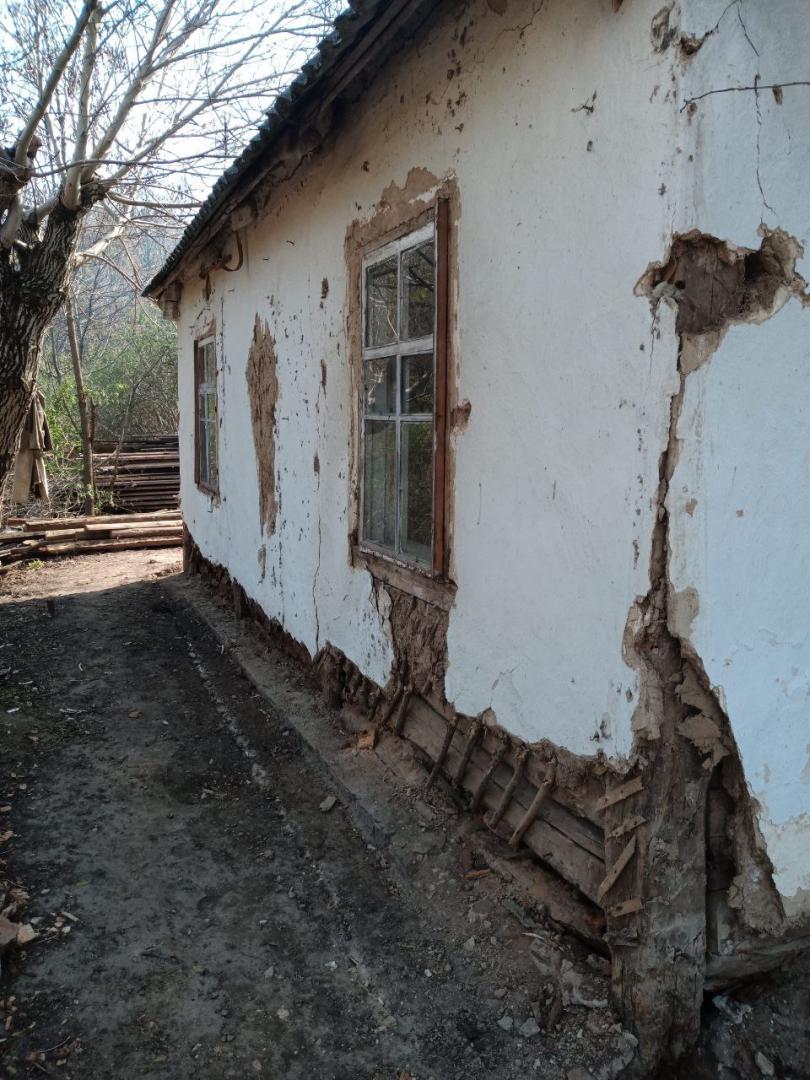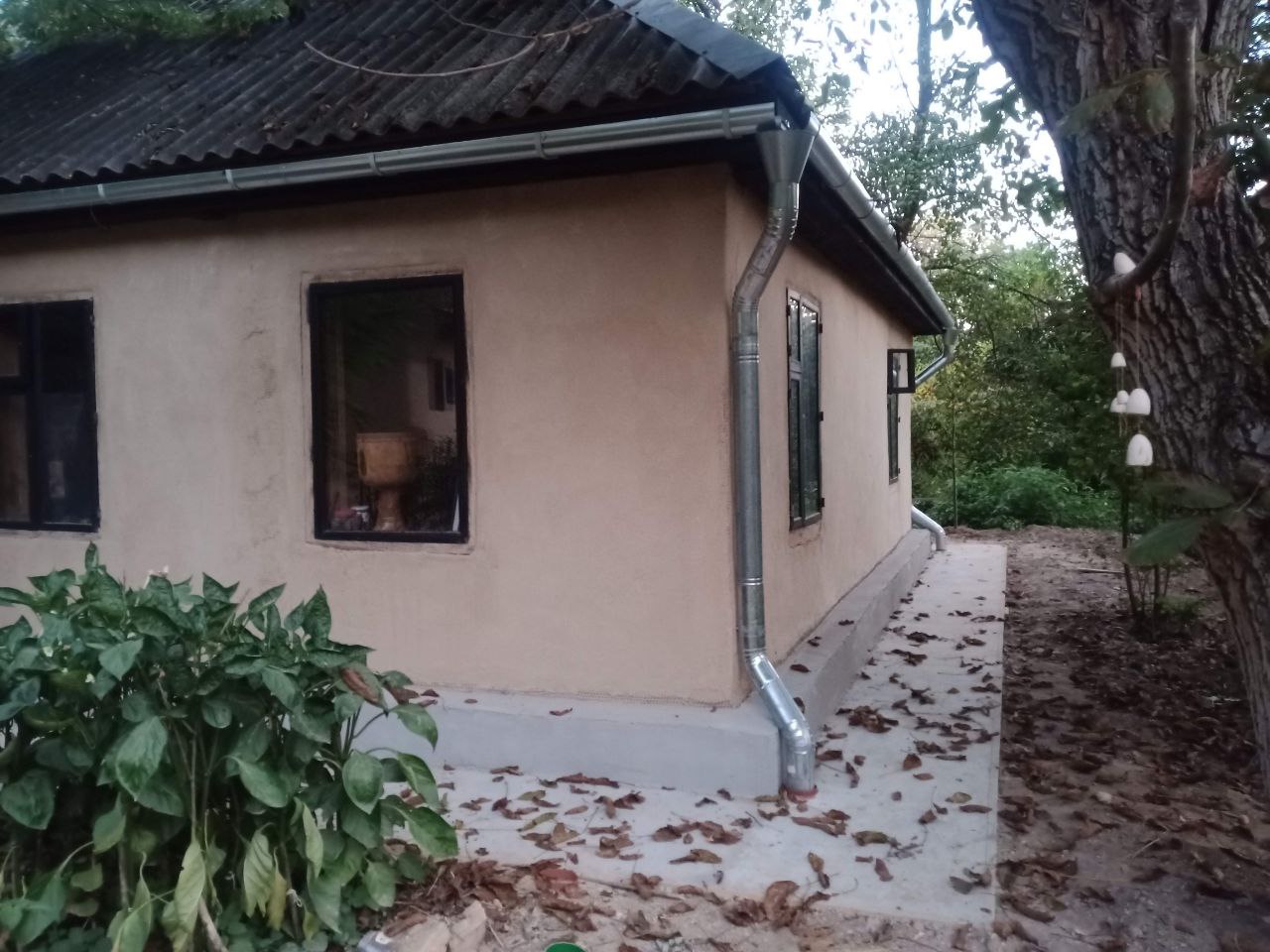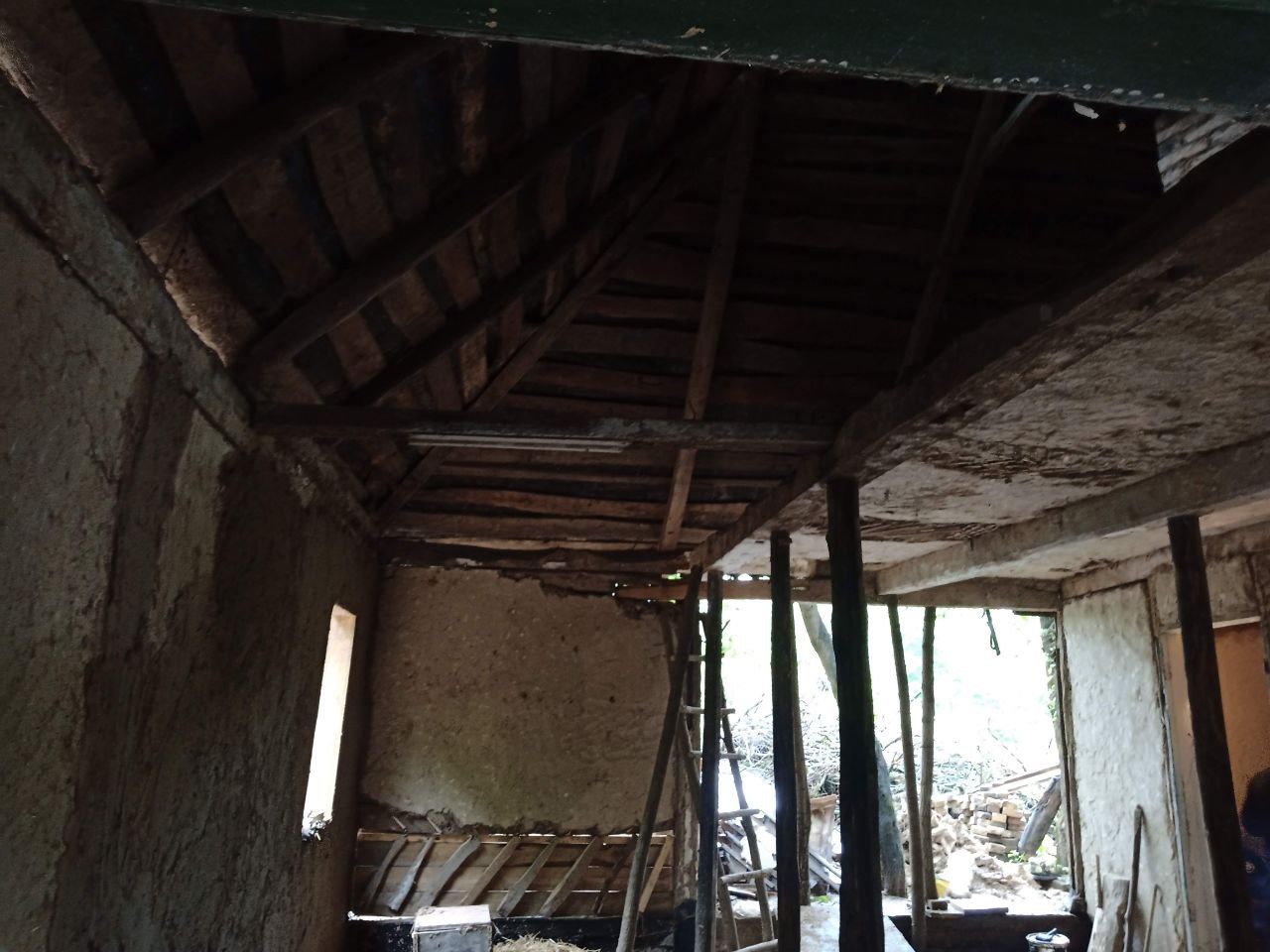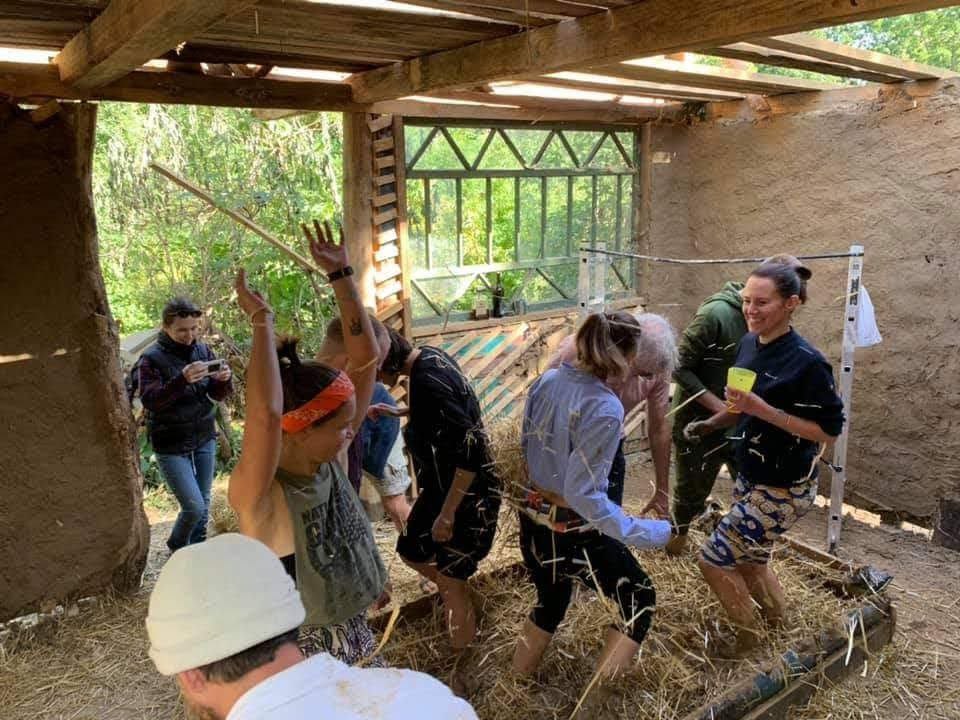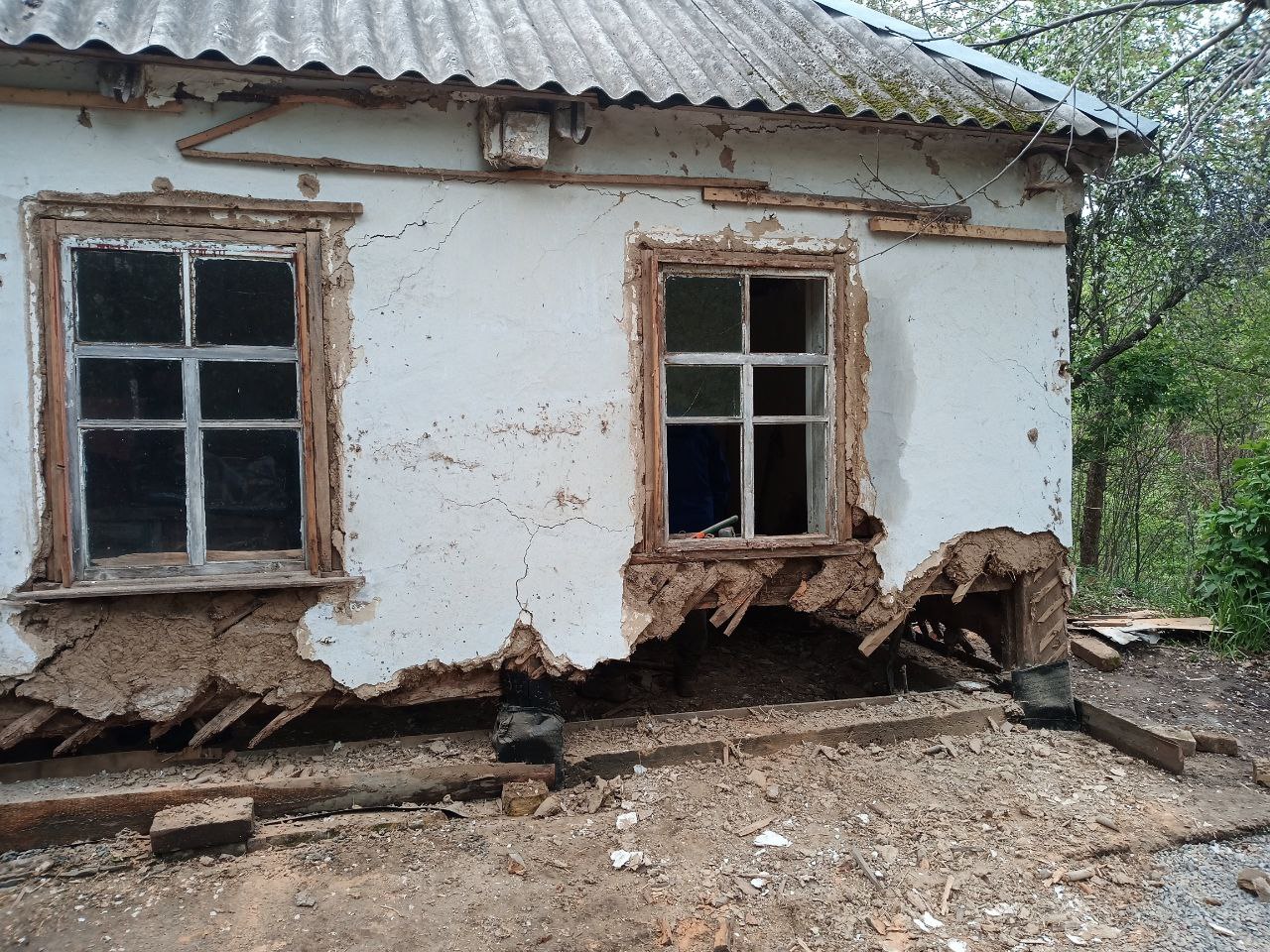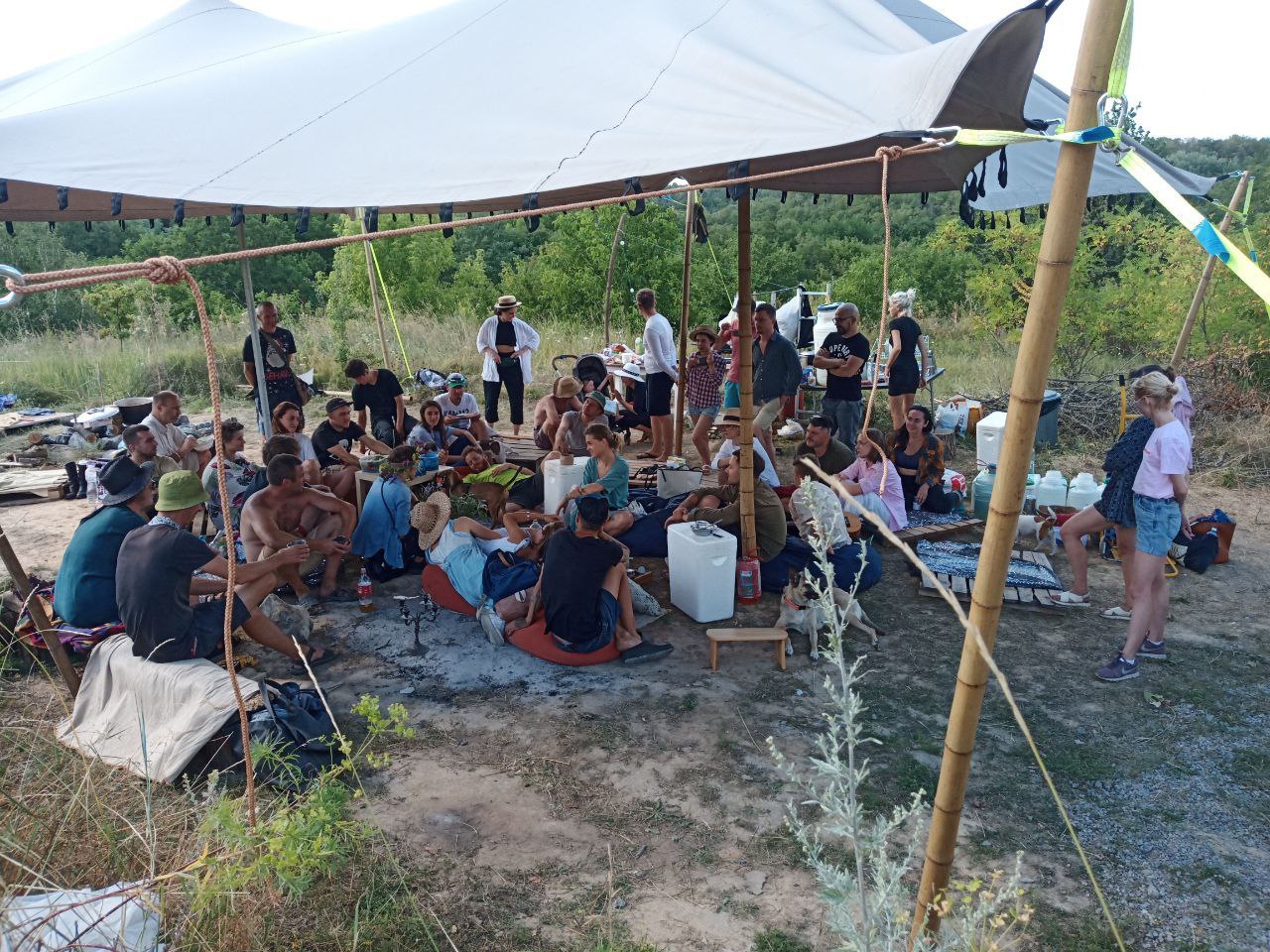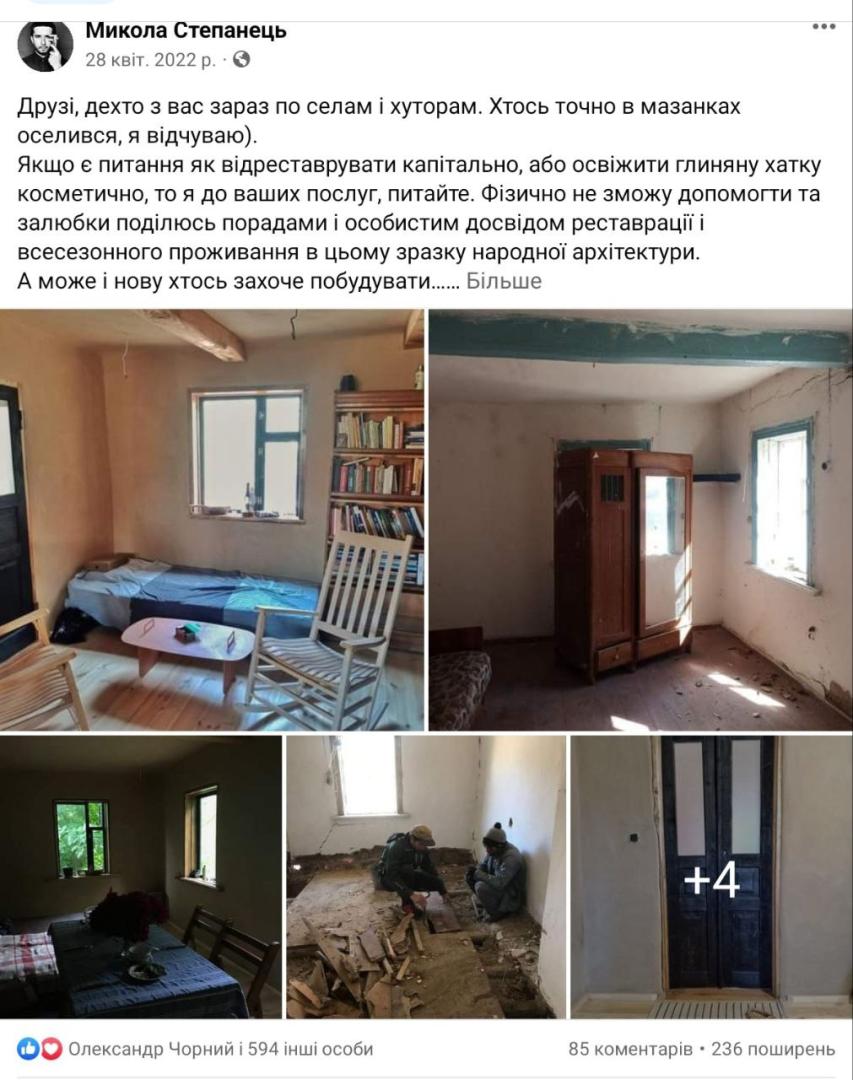Contemporary Mud Hut - MAZANKA
Basic information
Project Title
Contemporary Mud Hut - MAZANKA
Full project title
Contemporary Mud Hut MAZANKA - Еnough for my lifetime
Category
Regaining a sense of belonging
Project Description
Realizing the idea of restoring existing “mazanky” to meet the needs of modern people, but with respect for tradition, is what we call a local approach. When technologies, craftsmen, materials, and other resources are taken from as close as possible. This project is not (only) about beauty and tradition, but also about community building, because it involves all community members - the elderly, the low-income, people with disability, and the newcomers - internally displaced persons.
Geographical Scope
Local
Project Region
Ukraine, 09234, Kyiv region, Obukhiv district, Balyko-Shchuchynka village, 34 Poleva str.
, Ukraine
, Ukraine
Urban or rural issues
Mainly rural
Physical or other transformations
It refers to other types of transformations (soft investment)
EU Programme or fund
No
Description of the project
Summary
We are realizing the idea of restoring existing MAZANKA (Contemporary Mud Hut) to meet the needs of modern people, but with respect for tradition, is what we call a local approach. When technologies, craftsmen, materials, and other resources are taken from as close as possible.
Target group: residents of Balyko-Shchuchynka village and their friends from all over Ukraine.
Objectives:
1. Reconstruction of old abandoned housing for the needs of modern people, sustainable materials, testing the hypothesis that it is possible to restore the knowledge and skills of rebuilding traditional Ukrainian dwellings.
2. Real life in such conditions, checking whether it is really possible for a modern person.
3. Dissemination of knowledge, increasing the number of restorations of the fund of collapsed mazanok, practical advice.
Results achieved: the old mazanka was restored, three clean-ups were held, the last one was for 75 people, several news stories were filmed, one of them from Ukrainer received 116,000 views, after the project, the community began to build 2 more houses using this approach, consultations on traditional construction were held for everyone.
Our project promotes the values of the New Bauhaus by integrating concepts such as beauty, sustainability, interdisciplinarity, intersectionality, and intergenerational communication. The project combines local and global dimensions and utilizes the potential of participatory and interdisciplinary approaches. The project engaged local stakeholders in rethinking cultural heritage and highlighted the opportunities and prospects for sustainable housing revitalization - Revitalization using traditional building approaches at the national level. The MAZANKA project has had a positive impact on the community of Rzhyshchev through education, participatory activities, and the co-creation of traditional folk architecture - MAZANKA.
Target group: residents of Balyko-Shchuchynka village and their friends from all over Ukraine.
Objectives:
1. Reconstruction of old abandoned housing for the needs of modern people, sustainable materials, testing the hypothesis that it is possible to restore the knowledge and skills of rebuilding traditional Ukrainian dwellings.
2. Real life in such conditions, checking whether it is really possible for a modern person.
3. Dissemination of knowledge, increasing the number of restorations of the fund of collapsed mazanok, practical advice.
Results achieved: the old mazanka was restored, three clean-ups were held, the last one was for 75 people, several news stories were filmed, one of them from Ukrainer received 116,000 views, after the project, the community began to build 2 more houses using this approach, consultations on traditional construction were held for everyone.
Our project promotes the values of the New Bauhaus by integrating concepts such as beauty, sustainability, interdisciplinarity, intersectionality, and intergenerational communication. The project combines local and global dimensions and utilizes the potential of participatory and interdisciplinary approaches. The project engaged local stakeholders in rethinking cultural heritage and highlighted the opportunities and prospects for sustainable housing revitalization - Revitalization using traditional building approaches at the national level. The MAZANKA project has had a positive impact on the community of Rzhyshchev through education, participatory activities, and the co-creation of traditional folk architecture - MAZANKA.
Key objectives for sustainability
1. Sustainability. We care about the resource of materials and the resource of time (vitality). We take into account the environmental footprint of our activities in the future, using natural materials as much as possible. All the materials used for construction are very cheap, such as sand, clay, straw, and they are local. And if something needs to be purchased, it is purchased for very little money. People's work is also a minimal cost, because it is essentially the cost of lunch and dinner to feed those who gathered for the cleanup (joint unpaid work).
2. Involvement of a wide range of stakeholders
The project secured the support and participation of the following stakeholders: the local community (250 participants in the cleanup). After the project, the community began to build 2 more houses using this approach, consultations on traditional construction were held for everyone.
This project is not (only) about beauty and tradition, but also about community building, because it involves all community members - the elderly, the low-income, people with disability, and the newcomers - internally displaced persons. By joining the community, they establish valuable contacts and maintain social networks. Moreover, they can all expect to do the best they can at the project today, and that tomorrow someone will come to them and help.
3. Technical sustainability. The project minimized logistics. We have a restrained and no-frills approach to the methods of forming and processing materials. The value of a local approach in construction. Local: materials, technologies, and craftsmen.
This approach gives us independence from the market of industrial, often imported materials, and exchange rate-sensitive prices.
4. Ability to withstand crisis manifestations. This model of construction does not require the involvement of craftsmen from other regions, as it is based on the positive primitiveness of the technology of building a clay house.
2. Involvement of a wide range of stakeholders
The project secured the support and participation of the following stakeholders: the local community (250 participants in the cleanup). After the project, the community began to build 2 more houses using this approach, consultations on traditional construction were held for everyone.
This project is not (only) about beauty and tradition, but also about community building, because it involves all community members - the elderly, the low-income, people with disability, and the newcomers - internally displaced persons. By joining the community, they establish valuable contacts and maintain social networks. Moreover, they can all expect to do the best they can at the project today, and that tomorrow someone will come to them and help.
3. Technical sustainability. The project minimized logistics. We have a restrained and no-frills approach to the methods of forming and processing materials. The value of a local approach in construction. Local: materials, technologies, and craftsmen.
This approach gives us independence from the market of industrial, often imported materials, and exchange rate-sensitive prices.
4. Ability to withstand crisis manifestations. This model of construction does not require the involvement of craftsmen from other regions, as it is based on the positive primitiveness of the technology of building a clay house.
Key objectives for aesthetics and quality
The key goals of the project in terms of aesthetics are:
Preserving the design code of the Ukrainian village through the modernization of mazankas.
The first cleanup was for friends, and then it grew into a real festival with music, crafts, and practices. Then excursions were added to the process - about the ravine, about the river. Restoration does not require large capital investments.
The principle of local construction is to use the natural materials that are under our feet.
The idea was that we know that Ukraine has a large stock of huts, but no one knows how to turn this old housing stock into modern, relevant housing. Going to museums and seeing how people used to live is one thing, but living is something else. Our task is to build modern housing for a modern person based on cultural heritage so that it is not a museum for contemplation, but a place to restore a sense of belonging to the nation.
Belonging to the historical heritage, cultural heritage, traditional folk construction and crafts, and a way of life that respects local natural resources. Also, the relevance of the project to modern realities in Ukraine.
Preserving the design code of the Ukrainian village through the modernization of mazankas.
The first cleanup was for friends, and then it grew into a real festival with music, crafts, and practices. Then excursions were added to the process - about the ravine, about the river. Restoration does not require large capital investments.
The principle of local construction is to use the natural materials that are under our feet.
The idea was that we know that Ukraine has a large stock of huts, but no one knows how to turn this old housing stock into modern, relevant housing. Going to museums and seeing how people used to live is one thing, but living is something else. Our task is to build modern housing for a modern person based on cultural heritage so that it is not a museum for contemplation, but a place to restore a sense of belonging to the nation.
Belonging to the historical heritage, cultural heritage, traditional folk construction and crafts, and a way of life that respects local natural resources. Also, the relevance of the project to modern realities in Ukraine.
Key objectives for inclusion
The idea of building/restoring a mazanka is that you traditionally do it not alone, but together with the local community. That's why there are community clean-ups to build or restore a mazanka, and everyone comes together. When you mix the clay material for construction, it dries very quickly, so in our tradition, when building a mazanka, the whole family or even the whole hamlet (village) would gather and everyone would be together, helping each other build, children and grandparents-all age groups-because everything had to be done quickly. That is why this project is also about people who lived in this village for a long time and about people who came to live here - about IDPs. This project integrates them into the community. This project gives them knowledge about the origins of the cultural heritage and provides them with skills and understanding of the roots of the nation, unites them and explains the beauty of traditions.
Results in relation to category
Our project promotes the values of the New Bauhaus by integrating concepts such as beauty, sustainability, interdisciplinarity, intersectionality, and intergenerational communication. The project combines local and global dimensions and utilizes the potential of participatory and interdisciplinary approaches. The project engaged local stakeholders in rethinking cultural heritage and highlighted the opportunities and prospects for sustainable housing revitalization - Revitalization using traditional building approaches - at a national scale. The MAZANKA project has had a positive impact on the community of Rzhyshchev through education, participatory engagement and co-creation of traditional folk architecture - MAZANKSA
The project is:
Sustainable, as it is based on the principles of circularity, zero pollution and biodiversity;
inclusive, because it involves all community members - the old, the poor, the disabled, and IDPs. they can all expect to do the work they can and that someone will come to them and help them tomorrow;
interdisciplinary, as it covers the topics of sustainable development, rewilding, architecture, construction, culture and traditions;
aesthetic, as it proves the role of ancestral experience through design and cultural preferences;
intergenerational, as it promotes dialogue between children and their parents;
The project is:
Sustainable, as it is based on the principles of circularity, zero pollution and biodiversity;
inclusive, because it involves all community members - the old, the poor, the disabled, and IDPs. they can all expect to do the work they can and that someone will come to them and help them tomorrow;
interdisciplinary, as it covers the topics of sustainable development, rewilding, architecture, construction, culture and traditions;
aesthetic, as it proves the role of ancestral experience through design and cultural preferences;
intergenerational, as it promotes dialogue between children and their parents;
How Citizens benefit
The project is inclusive because it involves all members of the community - the old, the poor, the disabled, and the displaced. they can all expect to do the work they can and that tomorrow someone will come and help them. This project is not (only) about beauty and traditions, but also about community, because it involves all members of the community.
What the participants learned as citizens: the connection with cultural heritage and nature can be attractive to younger generations through the application of modern design principles and conscious ways of recreation.
The project involved the local community - about 250 participants in one cleanup. Now two more houses in the community have joined the project, and the active phase of construction is planned for the summer (as the building material is kneaded with feet in the warm season).
Project has contributed to the capacity building of civil society in the region, strengthen their ability and contribute to social and environmental improvements. In fact, in addition to its direct purpose of rebuilding traditional and abandoned housing in the village, the project contributed to social integration and solving the problems of IDPs. We facilitated cooperation between various stakeholders, including businesses and civil society organizations.Building such a strong partnership can increase the effectiveness and sustainability of not only project results, but also the capacity of local communities to address IDP issues.
Our engagement with local communities has demonstrated our respect for culture and its beauty, which contributes to the preservation of cultural heritage. In the area of environmental protection, we focus on ensuring sustainable practices, biodiversity conservation and responsible resource management. We contribute to the social and economic development of the community, being a driving force in ensuring inclusive, sustainable development that meets the aspirations of the community.
What the participants learned as citizens: the connection with cultural heritage and nature can be attractive to younger generations through the application of modern design principles and conscious ways of recreation.
The project involved the local community - about 250 participants in one cleanup. Now two more houses in the community have joined the project, and the active phase of construction is planned for the summer (as the building material is kneaded with feet in the warm season).
Project has contributed to the capacity building of civil society in the region, strengthen their ability and contribute to social and environmental improvements. In fact, in addition to its direct purpose of rebuilding traditional and abandoned housing in the village, the project contributed to social integration and solving the problems of IDPs. We facilitated cooperation between various stakeholders, including businesses and civil society organizations.Building such a strong partnership can increase the effectiveness and sustainability of not only project results, but also the capacity of local communities to address IDP issues.
Our engagement with local communities has demonstrated our respect for culture and its beauty, which contributes to the preservation of cultural heritage. In the area of environmental protection, we focus on ensuring sustainable practices, biodiversity conservation and responsible resource management. We contribute to the social and economic development of the community, being a driving force in ensuring inclusive, sustainable development that meets the aspirations of the community.
Physical or other transformations
It refers to other types of transformations (soft investment)
Innovative character
Thanks to the combination of modern design and primitive construction technologies, people can live in housing that meets the requirements of a modern person, is environmentally friendly and sustainable.
Disciplines/knowledge reflected
Our project promotes the values of the New Bauhaus because it integrates such concepts as beauty and interdisciplinarity. It is interdisciplinary because it covers the topics of sustainable development, rewilding, natural building, architecture, interior/exterior design, cultural heritage, culture and traditions. ecology, cooperative community skills, wild plants foraging, traditional crafts, local ethnoaesthetics. We hired local people to do various jobs, and it is important to us as a mission that local craftsmen work with local resources as they used to. That is, the craft heritage lives on in the hands of the craftsmen. They become the bearers of this knowledge, they become practitioners.
Methodology used
The technology of building and restoring mazanoks is a traditional technology, and it is publicly available in every village in Ukraine. This project has just once again confirmed the feasibility of these technologies in modern life. These technologies are not for old people, not for the poor as we think, these construction technologies can continue to be used by young people all over Ukraine just with the addition of modern design elements.
How stakeholders are engaged
At the local level, community members joined the project. They took part in a clean-up day (kneading clay, straw and sand with water in large vats using their feet), restored the walls of the house, and learned the methods of folk architecture in practice.
At the regional level, our project became interesting to the media, which turned it into a separate project. they brought the possibilities of modern Mazanka restoration to a wider audience across Ukraine.
At the regional level, our project became interesting to the media, which turned it into a separate project. they brought the possibilities of modern Mazanka restoration to a wider audience across Ukraine.
Global challenges
Many regions face rapid urbanization, leading to challenges such as inadequate infrastructure, environmental degradation, and social inequalities, Sustainable development, climate change, reduction of energy use, poverty reduct, green spaces, and community development.
1. Our project was focus on revitalizing natural landscapes, brownfield sites, or degraded ecosystems contribute to the global challenge of environmental conservation and sustainable resource management.
2. Revitalization of historical or cultural sites was contributed to the global challenge of preserving cultural heritage. Protecting and promoting cultural assets is essential for maintaining diversity and fostering mutual understanding.
3. Many global challenges, including socio-economic disruptions, require resilient communities. Revitalization project build community resilience through capacity building, social cohesion, and infrastructure improvements contribute to addressing these challenges.
4. We were focusing on revitalizing natural habitats contribute to the global effort to conserve biodiversity. This is crucial for maintaining ecosystem services, supporting wildlife, and ensuring the long-term health of the planet.
5. In many regions, rural areas face challenges such as depopulation and economic decline, but in rural communities can contribute to sustainable development.
6. Engaging with marginalized or vulnerable communities we have contributed to creating more inclusive societies.
1. Our project was focus on revitalizing natural landscapes, brownfield sites, or degraded ecosystems contribute to the global challenge of environmental conservation and sustainable resource management.
2. Revitalization of historical or cultural sites was contributed to the global challenge of preserving cultural heritage. Protecting and promoting cultural assets is essential for maintaining diversity and fostering mutual understanding.
3. Many global challenges, including socio-economic disruptions, require resilient communities. Revitalization project build community resilience through capacity building, social cohesion, and infrastructure improvements contribute to addressing these challenges.
4. We were focusing on revitalizing natural habitats contribute to the global effort to conserve biodiversity. This is crucial for maintaining ecosystem services, supporting wildlife, and ensuring the long-term health of the planet.
5. In many regions, rural areas face challenges such as depopulation and economic decline, but in rural communities can contribute to sustainable development.
6. Engaging with marginalized or vulnerable communities we have contributed to creating more inclusive societies.
Learning transferred to other parties
The technology of building and restoring mazanoks is a traditional technology, and it is publicly available in every village in Ukraine. This project has just once again confirmed the feasibility of these technologies in modern life. These technologies are not for old people, not for the poor as we think, these construction technologies can continue to be used by young people all over Ukraine just with the addition of modern design elements.
Keywords
Revitalization
Beauty
Cultural Heritage
Community
Sustainability

